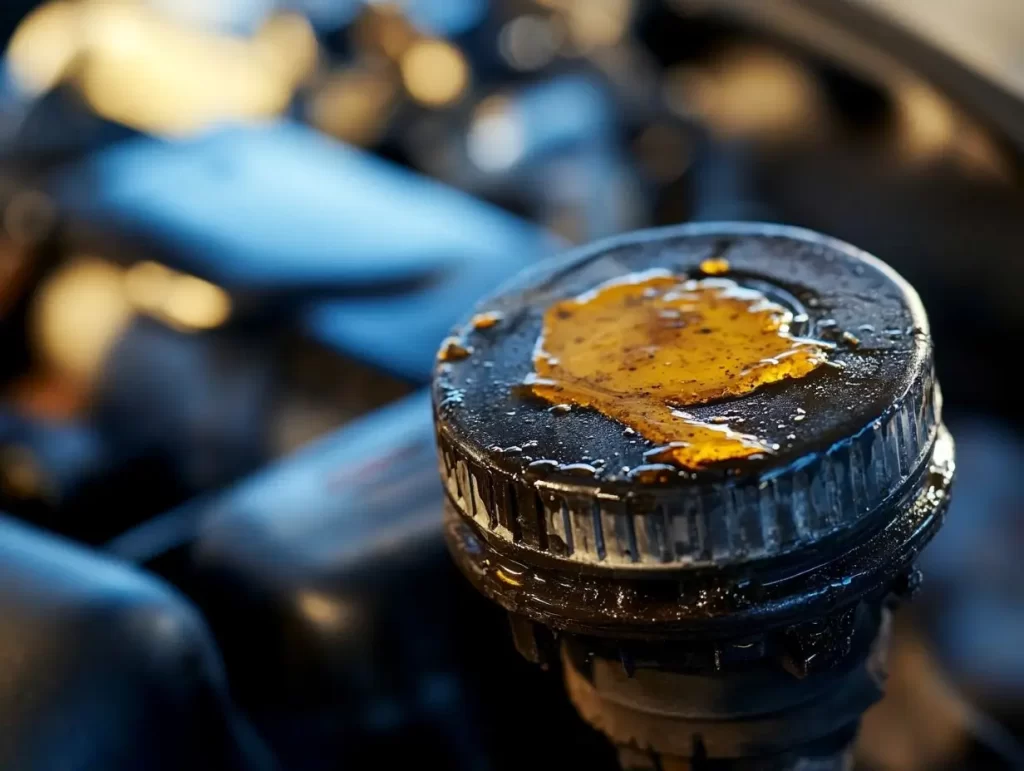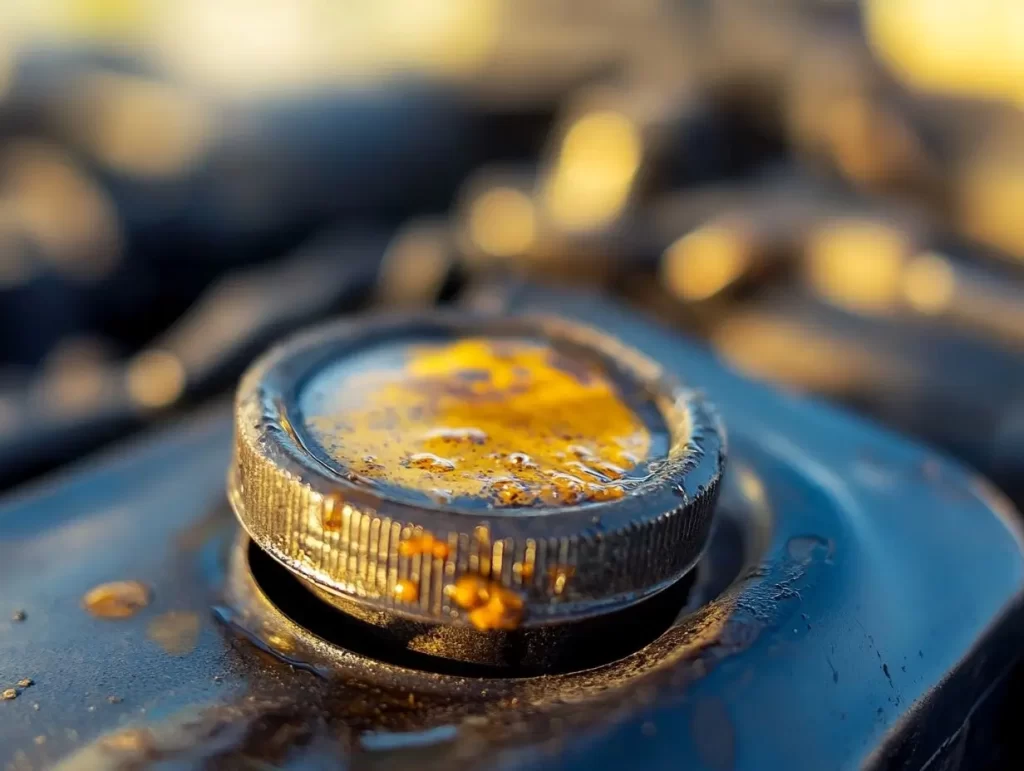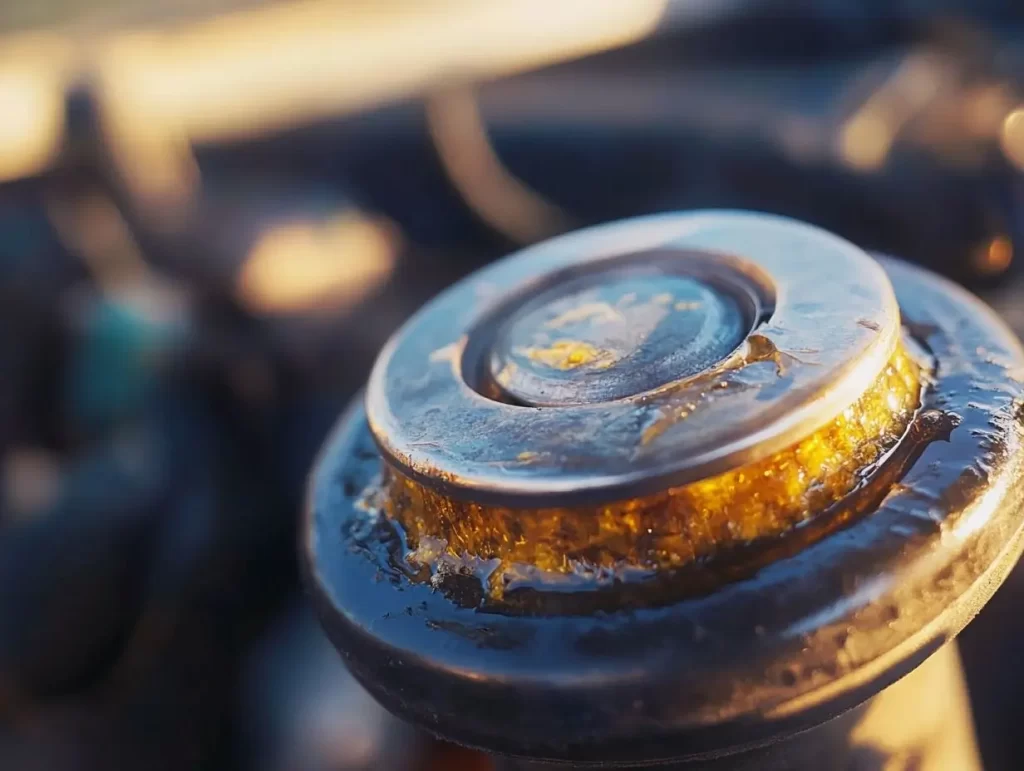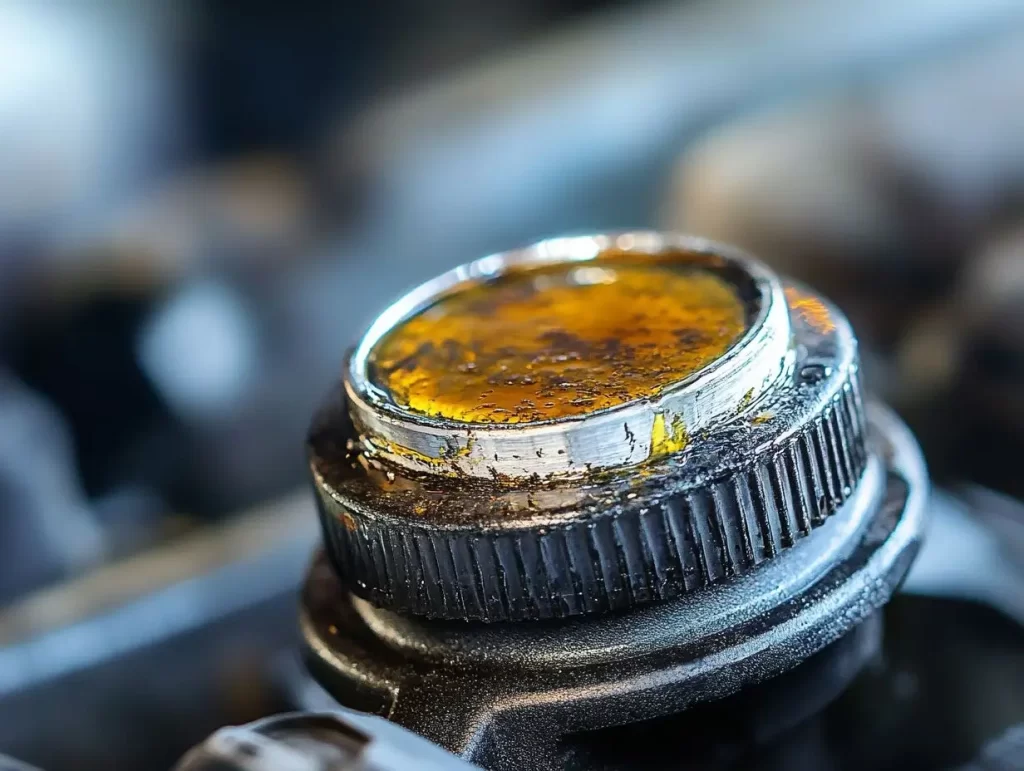What is this yellow sludge in my oil cap?
Have you noticed a thick, yellow sludge forming under your oil cap, you might be scratching your head about what that means for your engine. Could this gunk signal an underlying issue that could mess with your vehicle’s performance?
So, what could be causing this yellow sludge? It often comes from moisture buildup or engine oil contamination, and there are definitely some signs to keep an eye out for.
Do This First Test to Determine If Your Head Gasket is Blown!
With the car turned off, pull the oil dipstick and check the condition of the oil. If the oil is a whitish color and thick, there’s definitely a problem (mechanics call this the chocolate milkshake or milky oil).
If the oil looks normal, you probably only need to change your oil and your driving habits
Your best Johnson City auto mechanics have tips for prevention and treatment that can help keep your engine running like a dream.
SEE: Oil Change Service in Johnson City
Possible Causes of Yellow Sludge in Oil Cap

If you’ve spotted some yellow sludge under your oil cap, it can definitely be alarming. Understanding what’s behind it is key to keeping your vehicle’s engine in good shape.
Several factors could be at play here, like moisture buildup and engine oil contamination. If you don’t tackle these issues quickly, they can lead to some serious mechanical problems down the road. That sludge can mess with your oil quality, causing viscosity issues and even leading to engine failure if you let it go unchecked.
Moisture Buildup
Moisture buildup in your engine oil is one of the main culprits behind that pesky yellow sludge, and it can seriously mess with your vehicle’s performance and lifespan.
This unwanted moisture can sneak into your oil system through various channels—think condensation from temperature changes or those annoying coolant leaks. When coolant makes its way into the oil, you’re looking at some serious engine problems like reduced lubrication, faster wear and tear, and, worst case, catastrophic engine failure.
That’s why it’s essential to have a solid oil maintenance routine and stick to regular vehicle inspections. Catching those early signs of moisture and contamination can save you a lot of headaches. By keeping an eye on your oil quality and addressing any potential leaks right away, you can protect your engine from the damaging effects of moisture issues, ensuring it runs smoothly for years to come.
Engine Oil Contamination
Engine oil contamination can really stir up trouble for you, leading to nasty issues like yellow sludge forming under the oil cap. This can mess with your engine’s lubrication and overall health.
Now, this contamination can come from a few different places, like oil leaks that let dirt and debris sneak into the system or the breakdown of engine coolants that might introduce some unwanted gunk into your oil.
It’s crucial to understand that keeping your oil quality in check isn’t just about changing it regularly; using oil analysis services can give you valuable insights into your oil’s condition. This can help you spot potential problems before they blow up into something bigger.
Plus, incorporating oil additives can boost your engine’s performance by improving lubrication and reducing sludge build-up, ultimately protecting the longevity and efficiency of your vehicle’s engine.
Combustion Byproducts
Combustion byproducts are a big reason you might notice yellow sludge in your oil cap. They can really mess with your oil over time, leading to degradation and sludge buildup.
These byproducts—think unburned fuel, moisture, and carbon particles—mix with the oil and change its consistency, making it thicker and less effective at lubricating your engine components. If left unchecked, this could lead to wear and tear on crucial parts, which might cause performance issues like engine knocking or reduced fuel efficiency.
To tackle these problems, make sure you keep up with regular preventative maintenance. Timely oil changes and engine diagnostics can help you reduce the risks of sludge formation and keep your engine in top shape, ensuring optimal performance throughout its lifespan.
Signs and Symptoms of Yellow Sludge in Oil Cap

Spotting yellow sludge in your oil cap is usually the first clue that something’s not quite right, and catching these symptoms early can really help you keep your engine healthy and avoid a roadside breakdown.
Things like unusual oil color and consistency, along with various engine performance hiccups, can be signals that it’s time to take action. By recognizing these signs, you can take proactive steps to keep your engine running smoothly and ensure it lasts longer.
Ignoring these symptoms could lead to some serious engine trouble, so it’s super important to stay alert.
Visual Appearance
The visual appearance of yellow sludge can be quite telling, often showing up as a thick, yellowish residue under your oil cap. This little warning sign might mean there are potential issues brewing in your vehicle’s lubrication system. The last thing you want is milky oil.
Sometimes, this sludge can get even thicker, resembling a gel-like goop. That change can indicate that your oil quality is breaking down. As the oil degrades, it loses its ability to properly lubricate your engine, which can lead to increased friction and wear on those vital components you rely on.
If you notice the oil color shifting from a nice golden hue to a murky yellow, that could be an early sign of oil sludge forming. This buildup could lead to bigger engine problems down the line. If you don’t address it, it might restrict oil flow, which can cause overheating and even engine failure. That’s why keeping up with regular oil checks and changes is so important.
Engine Performance Issues
When you start noticing yellow sludge building up, it can really mess with your engine’s performance. You might see things like decreased oil pressure or even your engine overheating.
This sludge can interfere with some pretty essential engine parts, like oil pumps, filters, and even the combustion chamber, ultimately impacting your vehicle’s overall efficiency. That gunky buildup can restrict oil flow, which means inadequate lubrication and more wear on those vital components.
If you’re not on top of your oil maintenance like making timely changes and doing fluid analysis the risk of sludge buildup just keeps climbing.
Regularly checking your oil quality lets you catch issues early, making sure that impurities don’t compromise your engine’s integrity. So, taking a proactive approach to your fluid management is key to keeping your vehicle running smoothly and extending its lifespan.
Prevention and Treatment of Yellow Sludge in Oil Cap
Preventing yellow sludge in your oil cap is key to keeping your engine in tip-top shape, and a few simple practices can save you from those expensive repair bills later.
Regularly changing your engine oil, using high-quality oil and filters, and staying on top of preventative maintenance can really cut down on the chances of sludge buildup.
If you find that sludge has already made itself at home, don’t panic—options like an oil system flush or a professional cleaning can help get your engine back to its best and keep it running longer.
Regular Oil Changes and Maintenance

Regular oil changes and a solid maintenance schedule are key for keeping that yellow sludge from forming in your engine.
By sticking to the recommended oil change frequency, you can seriously boost your engine’s longevity and steer clear of those pricey repairs later on. Keeping an eye on your oil level not only helps maintain the right viscosity but also keeps those nasty contaminants away. If the oil gets dirty or breaks down, sludge can start building up, which can really mess with your car’s performance and efficiency.
Taking a consistent approach to managing your vehicle’s fluids not only protects your engine but also helps improve fuel efficiency. It’s a smart and economical choice for anyone who wants to extend their car’s life.
Using High Quality Oil and Filters
Using high-quality oil and filters is key to keeping your engine running like a dream and preventing nasty sludge from building up in your oil cap. It’s not just about having a clean oil system; it also plays a huge role in boosting your engine’s overall health.
Think of high-quality motor oil as your engine’s best friend. It lubricates all those moving parts, reduces friction, and helps prevent excessive wear—something you definitely want to avoid to steer clear of costly repairs. When you pair this oil with effective filters, you’re trapping harmful contaminants and stopping them from circulating, which means your engine keeps running smoothly.
Plus, those beneficial oil additives are no joke; they help with viscosity stability, keeping the oil pressure where it needs to be and cutting down on consumption. By investing in premium oil and filters, you’ll enjoy better fuel efficiency, a longer-lasting engine, and a more reliable ride overall.
Professional Cleaning and Repair Options
If you spot yellow sludge in your oil cap, it’s time to think about getting some professional cleaning and repair options to restore your engine’s health.
This yellow sludge may be a bigger problem, like coolant leaks or poor oil circulation, which can really mess up your engine if you ignore it. It’s smart to reach out to experienced technicians who specialize in things like oil system flushes and thorough engine cleaning. They know how to dig deep and figure out what’s really going on, plus they can handle the necessary repairs.
Taking timely action not only helps your vehicle last longer but also boosts its overall performance. Remember to keep up with regular maintenance tips, like checking your oil levels and doing routine inspections, to keep everything running smoothly.
Frequently Asked Questions
What is this yellow sludge in my oil cap?

The yellow sludge in your oil cap is likely a buildup of contaminants, such as dirt, debris, and oxidation, mixed with the engine oil. It is not normal and should be addressed immediately.
Why is there yellow sludge in my oil cap?
The yellow sludge in your oil cap can be caused by a variety of factors, such as infrequent oil changes, condensation, or a faulty PCV valve. It is important to identify the root cause to prevent further buildup.
Can yellow sludge in my oil cap damage my engine?
If left unchecked, yellow sludge in your oil cap can potentially damage your engine by clogging oil passages and preventing proper lubrication. It is important to address it promptly to avoid any potential damage.
How can I remove the yellow sludge from my oil cap?
You can remove the yellow sludge from your oil cap by using a degreaser and a cloth or brush. Be sure to thoroughly clean the cap and surrounding area to prevent any remaining sludge from contaminating the oil again.
Is the yellow sludge in my oil cap a sign of a serious problem?
The presence of yellow sludge in your oil cap is not necessarily a sign of a serious problem, but it should not be ignored. It is important to identify the cause and take necessary steps to prevent it from happening again.
Can I prevent yellow sludge from forming in my oil cap?
Yes, you can prevent yellow sludge from forming in your oil cap by regularly changing your engine oil and keeping up with proper maintenance. It is also important to address any underlying issues, such as a faulty PCV valve, that may contribute to the buildup of sludge.
